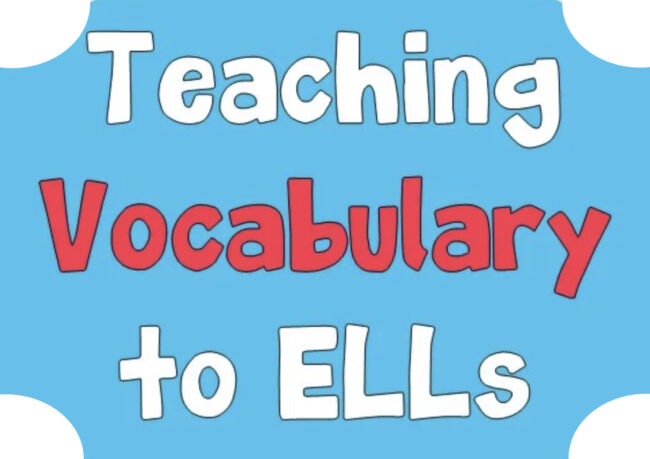Vocabulary Instruction for English Language Learners

(Note: This post was updated on March 20, 2024). Together with my colleagues at Keys to Literacy, I have recently updated the content in our Key Vocabulary Routine professional development course, including information related to vocabulary instruction for English language learners (ELLs). Vocabulary development plays a fundamental role in language learning and overall academic success. ELLs face unique challenges in acquiring English vocabulary due to limited exposure and differing linguistic backgrounds. This quote from Michael Graves sums up an important message for teachers of all grades and subjects:
“While most of the assistance we provide for ELLs will not be different in kind from that we provide for English only students, many ELLs will need to be taught more words, will need more powerful instruction, and will need to be given particular help in mastering word-learning strategies. This is also true of other students who enter school with small vocabularies.” (2016, p. 41)
Claude Goldenberg, an expert in the field of bilingual education, makes this point:
“In an English immersion classroom, where most ELLs are, the main challenge is that English learners are supposed to learn academic content that everyone is supposed to learn, while they are also learning the language the content is taught in. It’s a double-barreled challenge that English learners and their teachers face.”
The Five Components of Reading
Learning to read in a language one is simultaneously learning is very similar to learning to read in a language one already knows. The differences have to do with the writing and spelling systems of the first and second languages (Goldenberg, 2020).
The National Reading Panel report determined that students benefit from instruction in five components of reading: phonemic awareness, phonics, fluency, vocabulary, and comprehension (NICH, 2000). ELs benefit from the same instructional practices that have been found to be effective for teaching these reading components to all students. Goldenberg & Cardenas-Hagan (2023) note that Cheung and Slavin (2005) reviewed many of the same studies as the National Literacy Panel and concluded that “the programs with the strongest evidence of effectiveness for ELs are all programs that have also been found to be effective with students in general” and modified for Els (p.262). The report Developing Literacy in Second-Language Learners (August & Shanahan, National Literacy Panel on Language-Minority Children and Youth, 2006) concluded the same, explained in this recommendation:
“Instruction that provides substantial coverage in the key components of reading—identified by the National Reading Panel (NICHD, 2000) as phonemic awareness, phonics, fluency, vocabulary, and text comprehension—has clear benefits for language-minority students.” (p. 3)
Based on the major reviews for reading research among monolingual and second language learners, Cardenas-Hagan (2020) in her book Literacy Foundations for English Learners: A Comprehensive Guide to Evidence-Based Instruction explains the following:
“The same five components of literacy instruction that are important for monolingual English speakers are essential for second language learners, with some slight adjustments… The use of native language for the development of second language vocabulary skills is recommended. Examples include understanding cognates and word parts that are similar across languages and can assist with vocabulary development, which may also positively effect comprehension skills. It is important for educators to understand the oral language proficiency levels of ELs and incorporate language opportunities during instruction.” p. 41
Effective Vocabulary Instruction
In addition to using the same evidence-based vocabulary instruction that benefits all students, what else can educators do to develop the vocabulary of English Learners?
The research guide Effective Literacy and English Language Instruction for English Learners in the Elementary Grades (Gersten et al., 2007) recommends teachers provide high-quality vocabulary instruction throughout the day, including teaching essential content words in-depth. In addition, teachers should use instructional time to address the meanings of common words, phrases, and expressions not yet learned.
Effective vocabulary instruction for ELs involves a combination of explicit teaching, context-rich learning experiences, and strategies that promote active engagement and meaningful practice. Graves makes the following points about effective ELs vocabulary instruction:
- The development of strong language skills in students’ first language is a cornerstone for building
- English.
- ELs often need substantial repetition and reinforcement, and more frequent exposures during school.
- ELs benefit from differentiated instruction and scaffolding to allow them to carry out tasks beyond their independent abilities.
- ELs benefit from learning and guided practice for use of context and word parts to determine the meaning of unfamiliar words.
Pollard-Durodola (2020) also emphasizes providing frequent explicit and varied vocabulary instruction throughout the school day so that learning new words in a second language is not left to chance. These frequent opportunities should encourage ELs to be immersed in listening, speaking, reading, and writing new words during content-enriched instruction. Informal opportunities to use new words do not provide sufficient robust exposures to new vocabulary that can only take place through intentional planning that emphasizes deciding which words to teach and which word-building strategy is most appropriate.
Teaching and Discussing Words in Meaningful Contexts
Research finds that vocabulary instruction that is integrated into the teaching of academic subjects is effective (Graves et al., 2012). Pollard-Durodola (2020) notes that decontextualized vocabulary instruction where students memorize word lists, terms, and their meanings in isolation are not as effective for ELs as instruction that connects to students’ background knowledge and exposure to words in context. ELs require rich and deep word processing opportunities because they may lack English word depth even for words that are frequently encountered in the second language.
Content-enriched vocabulary practices focus on explicit exposure to content-related words that are important for students to be able to independently read and comprehend academic texts. This approach ensures that ELs not only acquire English vocabulary but also develop the necessary content knowledge to succeed academically.
The Meadows Center for Preventing Educational Risk at the University of Texas at Austin (2018) recommends the following about teaching vocabulary as part of content learning in its guide 10 Key Policies and Practices for Teaching English Language Learners based on findings from high-quality research:
Teachers should provide intentional, explicit, and extended vocabulary instruction that supports content learning:
“The volume and complexity of vocabulary associated with academic instruction increases exponentially through the grades, making learning especially difficult for ELs, who often find the vocabulary load to be overwhelming… But exposure to words alone is insufficient; students need to use words within and across subjects. Explicit instruction of key words anchored to text can accelerate students’ acquisition of vocabulary, especially when students have extended opportunities to use words in meaningful contexts. For ELs to understand words at more than a surface level, instruction must be extended over time with opportunities to hear, speak, and write words across varied contexts.” (p. 7)
The guide goes on to suggest these explicit vocabulary instruction steps:
- State the word and give a comprehensible definition that uses language your ELs will understand.
- Give two or more examples, briefly explaining why they are examples of the target word.
- Give two or more non-examples, briefly explaining why they are not examples of the target word.
- Discuss, pulling in students’ background knowledge of the word.
- Check for understanding with questions and prompts.
- Have students use target words in speaking and writing.
- Use systematic review to provide opportunities over time for students to read, write, hear, and say the target words.
- Use “intentional noticing” to discuss target words and how they are used as you encounter the words across contexts.
Teaching Related Words & Cognates
Filmore and Snow (2018) recommend providing exposure to new vocabulary in related groups (word families) because many words are meaningful when they are understood in connection with other words related to the same general topic. This enables ELs to learn several words at once. Semantic Mapping, Semantic Feature Analysis, Categorizing, and Scaling are activities in The Key Vocabulary Routine that provide opportunities for students to learn related words. Learn more about semantic mapping in an earlier post.
Cognates are words in two languages that have common etymological roots and share a similar meaning, spelling, and pronunciation, such as the English/Spanish examples below.
- analyze – analizar
- benefit – beneficio
- define – definer
- distribute – distribuir
- geography – geografia
- identify – identificar
- indicate – indicar
- individual – individua
Cognate awareness is the ability to use cognates in a primary language as a tool for understanding a second language. Goldenberg (2013) notes that while no study has ever isolated the specific effects of cognate instruction, more successful second-language learners do use cognates when trying to understand material in the second language.
Many words in English come from French/Latin contributions to English. Therefore, some words in related languages such as Spanish, French, Italian and Portuguese have a clear meaning connection to these words. Because there are a number of common academic words that have clear Spanish/English cognate awareness is especially helpful for Spanish-speaking students as a bridge to the English language.
Students can be taught to use cognates as early as preschool. As they move into upper grades, students can be introduced to more sophisticated cognates, and to cognates that have multiple meanings in both languages (Colorin Colorado).
Additional Instructional Suggestions
Technology-enhanced instruction: Technology offers promising avenues for teaching vocabulary to ELLs. Digital tools and applications can provide interactive and engaging experiences that cater to individual learner needs. Computer-assisted programs, online resources, and mobile applications offer opportunities for independent practice, self-assessment, and personalized learning experiences.
Cultural sensitivity and respect for ELLs’ linguistic backgrounds: Educators should keep in mind Incorporating students’ native languages, encouraging cross-linguistic connections (such as pointing out English words that share cognates with ELLs’ first language), and recognizing the value of bilingualism can enhance vocabulary instruction and promote a positive learning environment.
Overall Suggestions: Based on studies on explicit vocabulary instruction with English learners, extensive research with native English speakers, and expert opinion, the research guide Effective Literacy and English Language Instruction for English Learners in the Elementary Grades (Gersten et al., 2007) recommends the following for teaching vocabulary to ELs.
1. Adopt an evidence-based approach to vocabulary instruction.
- An evidence-based approach should require that teachers provide daily explicit vocabulary instruction. Evidence-based vocabulary instruction should be a strong part of reading instruction and an integral part of instruction in all subjects.
- Researchers converge in noting that effective vocabulary instruction includes multiple exposures to target words over several days and across reading, writing, and speaking opportunities.
- A small but consistent body of intervention research suggests that English learners will benefit most from rich, intensive vocabulary instruction that emphasizes “student-friendly” definitions that engage students in the meaningful use of word meanings in reading, writing, speaking, and listening, and that provides regular review.
- The goal of rich vocabulary instruction is for students to develop an understanding of word meanings to the point where they can use these and related words in their communication and as a basis for further learning.
- The core reading program used in the classroom is a good place to begin choosing words for instruction and methods for teaching them. For English learners, additional words need to be identified for instructional attention, and teaching procedures need to be much richer and more extensive than instruction usually recommended within core reading programs.
2. Develop districtwide lists of essential words for vocabulary instruction.
- These words should be drawn from the core reading program and from the textbooks used in key content areas, such as science and history.
- A major part of any vocabulary curriculum is specifying the words to be taught. Adopting a districtwide core vocabulary list for English learners will help focus instruction on valuable words and reduce unnecessary duplication.
- A core vocabulary list does not prevent teachers or students from adding to this list when problem words arise in the classroom—in fact, some districts even build in space for the addition of such words.
- The lists currently identified in core reading programs are inadequate for this purpose. They often fail to emphasize the words most critical for understanding a story or most useful for the child’s language development.
- For example, many vocabulary lists stress decoding issues rather than meaning. Thus, to accomplish vocabulary instruction goals, districts must develop their own lists and provide access to these lists for their teachers.
- Words for instruction should be selected carefully. Long lists of words cannot be taught in depth because rich vocabulary instruction is time intensive. Only a handful of words should be taught in intensive ways at any one time. Some authorities recommend teaching only about eight to ten words per week this way, while others suggest teaching two to three words per day (but always with lots of future review and extension).
3. Vocabulary instruction for English learners should also emphasize the acquisition of meanings of everyday words that native speakers know and that are not necessarily part of the academic curriculum.
- The vocabulary gap between English learners and native English speakers is substantial because English learners do not know many of the simpler words or conversational words that native English speakers acquire before they enter school or learn in school without explicit teaching.
- Many of these words are crucial for understanding text and other academic content. For example, English learners may not know such words as bank, take, sink, or can.
- Textbook publishers assume that students know these words and do not include them as vocabulary targets. Nor do they provide recommendations for how to address teaching these words should teachers have students who do not know them.
- English learners can acquire these words easily if teachers provide them with brief instruction during lessons. This instruction can emphasize the meanings of common phrases and expressions, not just single words.
- During reading instruction, teachers can teach many of these common words explicitly—in roughly the same way that they teach content words, but much more quickly. They can teach many words as they arise in the classroom, drawing attention to the potentially confusing word and phrases.
Additional Resources
- Best Practices for ELLs: Vocabulary Instruction (Reading Rockets)
- Tips for Educators of ELLs: Teaching Vocabulary in Grades 4-12 (Colorin Colorado)
- A Multidimensional Approach to Vocabulary Instruction: Supporting English Language Learners in Inclusive Classrooms (Colorin Colorado)
- Video: Teaching Academic Vocabulary to High School ELLs (Colorin Colorado)
- Promoting Vocabulary Development in Young English Learners (University of North Carolina)
- Institute of Education Sciences Videos:
References
- August, D., & Shanahan, T. (Eds.). (2006). Developing literacy in second-language learners: Report of the National Literacy Panel on Language-Minority Children and Youth. Lawrence Erlbaum Associates Publishers.
- Baker, S., Geva. E., Kleffer, M.J., Lesaux, N., Linan-Thompson, S., Morris, J., Proctor, C.P., & Russell, R. (2014). Teaching academic content and literacy to English learners in elementary and middle school. Washington DC: National Center for Education Evaluation and Regional Assistance, Institute of Education Sciences, U.S. Department of Education.Cardenas-Hagan, E. (2020). Literacy foundations for English learners: A comprehensive guide to evidence-based instruction. Baltimore, MD: Paul H. Brookes.
- Cardenas-Hagan, E. (2020). Literacy foundations for English learners: A comprehensive guide to evidence-based instruction. Baltimore, MD: Paul H. Brookes.
- Cheung, A. & Slaven, R. (2005). Effective reading programs for English Language Learners and other language-minority students. Bilingual Research Journal, 29(2). 241-267.
- Colorin Colorado. Using cognates to develop comprehension in English. Retrieved from: https:www.colorincolorado.org/article/using-cognates-develop-comprehensin-english
- Filmore, L.W., & Snow, C. E. (2018). What teachers need to know about language. In C.T. Adger, C.E. Snow, & D. Christian (Eds., What teachers need to know about language (2nd ed.). Multilingual Matters.
- Gersten, R., Baker, S.K., Shanahan, T., Linan-Thompson, S., Collins, P., & Scarcella, R. (2007). Effective Literacy and English Language Instruction for English Learners in the Elementary Grades: A Practice Guide (NCEE 2007-4011). Washington, DC: National Center for Education Evaluation and Regional Assistance, Institute of Education Sciences, U.S. Department of Education.
- Goldenberg, C. & Cardenas-Hagan. (2023). Literacy research on English learners: Past, present, and future. The Reading League Journal, January/February, 2023.
- Goldenberg, C. (2013). Unlocking the research on English learners: What we know and don’t yet know about effective instruction. American Educator, Summer 2013.
- Goldenberg, C. (2020). Reading wars, reading science, and English learners. Reading Research Quarterly, 55(S1).
- Graves, M.F. (2016). The vocabulary book: Learning and instruction, 2nd Edition. New York, NY: Teachers College Press.
- Graves, M.F., August, D., & Mancilla-Martinez, J. (2012). Teaching vocabulary to English language learners. New York, NY: Teachers College Press.
- The Meadows Center for Preventing Educational Risk (2018). 10 key policies and practices for teaching English language learners. The University of Texas at Austin.
- Pollard-Durodola, S.D. (2020). Vocabulary instruction among English learners. In E. Cardenas-Hagan (Ed.). Literacy foundations for English learners. Baltimore, MD: Paul H. Brookes.
- NICH: National Institute of Child Health and Human Development. (2000). Report of the National Reading Panel. Teaching children to read: An evidence-based assessment of the scientific research literature on reading and its implications for reading instruction (NIH Publication No. 00-4769). Washington, DC: U.S. Government Printing Office.

 Joan Sedita is the founder of Keys to Literacy and author of the Keys to Literacy professional development programs. She is an experienced educator, nationally recognized speaker and teacher trainer. She has worked for over 35 years in the literacy education field and has presented to thousands of teachers and related professionals at schools, colleges, clinics, and professional conferences.
Joan Sedita is the founder of Keys to Literacy and author of the Keys to Literacy professional development programs. She is an experienced educator, nationally recognized speaker and teacher trainer. She has worked for over 35 years in the literacy education field and has presented to thousands of teachers and related professionals at schools, colleges, clinics, and professional conferences.
Leave a Reply